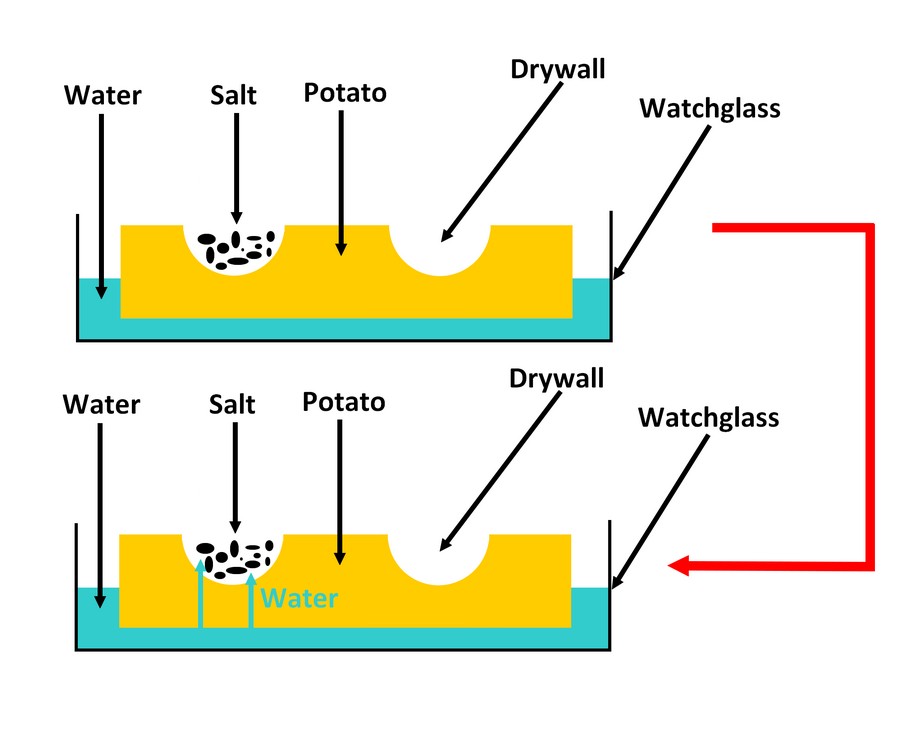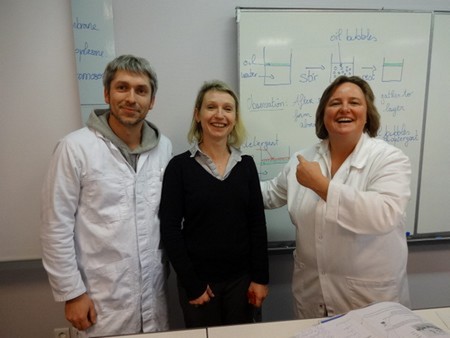Desoxyribo Nucleic Acid extraction protocol.
To do this experiment we had to first learn what a cell and a membrane contained. We know where the genetic information is situated: in the cell nucleus.
The DNA is situated in a cell but the cell is surrounded by a membrane, to extract the DNA we must break the membrane and absorb the cytoplasm filled of 70% of water. To realize it, we did 3 experiments (to explain the main experiment.)






I. The osmosis
First, we cut the potato in half and we put it in a watchglass.Then, in the watchglass, added water at the bottom with the pipette.
We made 2 little craters on the top of the potato and dried the craters. Filled the first crater with salt, and then waited for a moment.





We observed that the crater of salt got filled with water.
Because the crater is highly concentrated in salt, so to find equilibrium, the water is sucked in the crater by osmosis.
II. Dissolving the membrane
To dissolve the membrane, we took a beaker and added water then oil. We stirred the mixture with the glass rod and then we waited for a moment.










After rest, we could observe that oil bubbles gather to form a homogeneous layer above the water.
Then we added the detergent at the water/oil mixture and stirred the layer with the glass rod.We waited a few minutes.






We observed that with the detergent, the emulsion is stable. The oil layer doesn’t form again.
The detergent helps separating the lipids. The detergent fragilized the membrane because it is mainly consisted of lipids.
III. The role of ethanol
In a test tube we added ethanol in an oversatured salt solution and stirred the layer.








Ethanol makes the salt solid again.
Salt doesn’t dissolve in ethanol so when we added ethanol in the oversatured salt solution, we collected solid salt.
IV. Final experiment : collecting the dissolved DNA
In the preceding experiment we saw that with ethanol we could collect solid salt so if we added ethanol in the preparation, wecollected a DNA sample, because the salt and the DNA are not soluble in the ethanol.
We peeled the banana and cut it in small dice. We
put the dice in the mortar, and then we added a soup spoon of coarse
salt. With the pestle we ground the layer. We added 10mL of detergent
and 30mL of water with the pipette.
We waited 5 minutes.




































We
observed the banana
DNA (the medusa) in the ethanol and under it was the banana filtrate.
We
could
collect the DNA, because it is not soluble in the ethanol but if we
put the DNA in water we could not see it any more.

During
this afternoon we learnt
a lot of new words in English (and in French…), we noticed that the
English scientific words looked like the French words.The
main experiment was not easy to understand but with other experiments
in parallel we understood the role of the salt and the ethanol.
We
knew that the nucleus contained the DNA but with experiments we
understood more easily. We appreciated this experiment and we hope we
can redo experiments
like it before the end of the year (and in English) !!
BOLLECKER Léa & DIETSCH Aurore